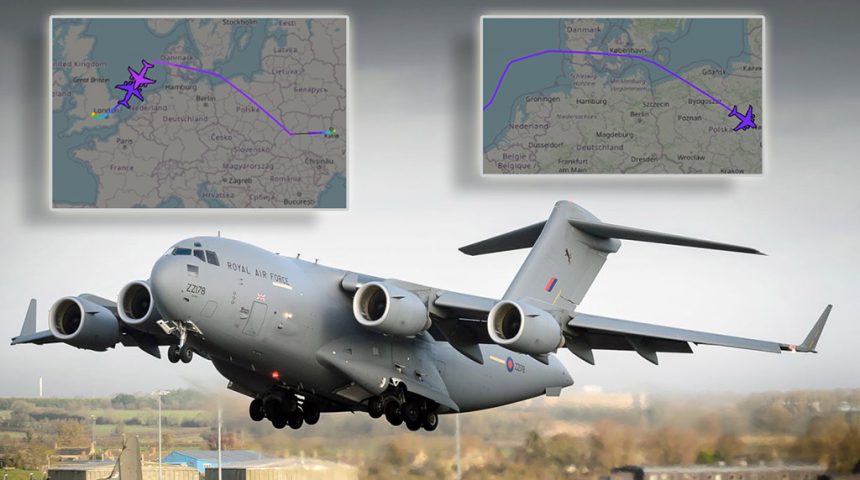The decision to avoid the German airspace was made deliberately by the Royal Air Force C-17s and the British were not really forced to fly around the German territory.
Contrary to media reports published on Jan. 17, 2022, Germany did not deny British C-17 transport aircraft access to their airspace. RAF’s C-17s were supposedly carrying light anti-armor weapons to Ukraine, to beef up the local defences as a consequence of the Russian military buildup near the Ukrainian border.
British Defense Secretary Ben Wallace unveiled London’s plans to supply Ukraine with light anti-tank defense weapons during a speech in the UK Parliament.
“Tens of thousands of Russian troops are positioned close to the Ukrainian border. Their deployment is not routine, and they are equipped with tanks, armoured fighting vehicles, rocket artillery, and short-range ballistic missiles,” Wallace said in a statement to the House of Commons on the situation in Ukraine yesterday.
“We, and our Allies, have legitimate and real cause for concern that the configuration and scale of the force being assembled, supported by Russian air and maritime long-range strike capabilities stationed in the region, could be used for the purpose of conducting a multi-axis invasion of Ukraine.”
“We have taken the decision to supply Ukraine with light, anti-armour, defensive weapon systems. A small number of UK personnel will also provide early-stage training for a short period of time, within the framework of Operation ORBITAL, before then returning to the United Kingdom.”
Speculations that the delivery of the announced anti-armour weaponry could have taken a different route because of Berlin’s denial started to circulate observing the route followed by the RAF Globemaster III cargo aircraft on flight tracking websites: the C-17s flew across the Danish and Polish airspaces instead of going “direct” through the German airspace.
🚨 BREAKING NEWS | British C-17 transport aircraft are currently ferrying anti-armour weaponry to Ukraine in the face of increasing Russian rhetoric. pic.twitter.com/ZsMyDQoZPw
— George Allison (@geoallison) January 17, 2022
While the actual route chosen for a military transport flight depends on several factors (time of the day, Diplomatic Clearances already available, flight restrictions, active NOTAMs, weather, etc.) the main theory on social media was that the aircraft were forced to fly outside of the German airspace because Berlin had denied the clearance to do so.
However, things got clarified on Jan. 18, 2022, when Julian Roepcke published a tweet today, stating that the German MoD did not deny the C-17s flying from Brize Norton through the German Airspace.
The German defence ministry says it did not ban the UK from using German airspace for its C-17 flights to Ukraine; simply that it received no such application. (See https://t.co/XR2poVn6ix) https://t.co/PNm41ZDWHG
— Tom Nuttall (@tom_nuttall) January 18, 2022
In fact, it seems that the decision to avoid the German airspace was made deliberately by the RAF planners, and the British C-17s were not really forced to fly around the German territory: aircraft carrying specific kinds of cargo and/or weapons require a dedicated clearance that the UK did not apply for (for reasons yet to be disclosed – although time might have been a factor here); hence the route avoiding the German airspace.
At the same time, as noted by several reporters and analysts, while the nature of their mission is completely different, Germany has no problem in allowing NATO SIGINT/ELINT assets to fly through its airspace on their way to Ukraine, were several ISR (Intelligence Surveillance Reconnaissance) aircraft are operating in these days, to keep an eye on the movement of forces near the borders.
Fun fact for those decrying Germany allegedly blocking allied flights to #Ukraine: Here’s one going across Germany. (Cargo flights with dangerous items like ammunition require a dedicated clearance, which the UK did not apply for according to @BMVg_Bundeswehr) https://t.co/fsXng7hcP8
— thomas_wiegold (@thomas_wiegold) January 18, 2022
Indeed, as a consequence of the reported military buildup of Russian forces in the region we have observed a spike in U.S. and NATO surveillance over northern and eastern Ukraine, with the involvement of RC-135s and E-8C Joint Surveillance Target Attack Radar System (JSTARS).
#Ukraine
-USAF RC135W Rivet Joint JAKE11
-USAF E8C Joint STARS REDEYE6 pic.twitter.com/CR5FH1Rwwe
— Manu Gómez (@GDarkconrad) January 18, 2022
The E-8C J is a joint U.S. Air Force – Army program whose capabilities were described in a previous article we published here at The Aviationist:
The JSTARS is an airborne battle management, command and control, intelligence, surveillance and reconnaissance platform. It uses a multi-mode side looking radar to detect, track, and classify moving ground vehicles deep behind enemy lines. Its primary mission is to provide theater ground and air commanders with ground surveillance to support attack operations and targeting: through an antenna that can be tilted to either side of the aircraft to develop a 120-degree field of view, the JSTARS can cover nearly 19,305 square miles (50,000 square kilometers) and detect targets from a distance of 250 kilometers. Although the E-8C’s role is to build and update the picture of the battlefield, focusing on ground and moving targets, the the radar has also limited AEW-like capabilities: it can also detect helicopters, rotating antennas and low, slow-moving fixed wing aircraft even though these are partially hidden in the ground clutter. Surveillance data can be relayed in near-real time to the Army and Marine Corps common ground stations and to other ground command, control, communications, computers and intelligence, or C4I, nodes.
The E-8C can be particularly useful to keep an eye on the Russian forces that have been moved to Ukraine’s northern neighbour Belarus for joint military exercises, in a move believed to increase fears in the west that Moscow is preparing for an invasion. An invasion that Ukraine prepares to face with the help of NATO weapon supplies, like those reportedly delivered by the British C-17s.









